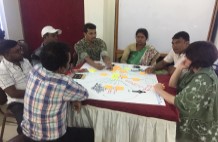Articles

Workshop with aquaculture farmers in Bangladesh. Credit: Steve Hinchliffe
Production without medicalisation in Bangladesh aquaculture
Aquaculture farm management practices to reduce disease burden and medicalisation must align to the socio-economic and ecological conditions facing aquaculture farmers in low-middle income countries.
A study by University of Exeter and Sustainable Aquaculture Future researchers has explored the risk practices and drivers of disease in Bangladesh aquaculture. They show interventions striving for disease free status are largely incompatible with the supply chain and livelihoods of aquaculture farmers in low-middle income countries. Instead, diversification of crops and more frequent stocking are suggested to minimise risk for farmers and reduce indiscriminate use of medicines.
Lead author Professor Steve Hinchliffe, from the University of Exeter, said: “It is really important to avoid a one size fits all approach to modernising farming practices – especially in the Global South. Improvements need to work with rather than against the grain of established farm practices.”
Aquaculture is the fastest growing major food production sector striving to feed a growing population, with 90% of growth focused in Asia. Disease represents a major barrier to aquaculture’s continued expansion. For instance, the global shrimp industry is estimated to lose 40% of annual production to disease. To combat disease, farmers are increasingly pressured to use treatments, including antimicrobials. The increasing contribution of aquaculture to antimicrobial use in the food and farming sector poses a significant potential risk to global antimicrobial resistance.
To tackle the issue of disease and antimicrobial usage, Prof Steve Hinchliffe and colleagues examined food production intervention strategies by employing a multi-method field study including interviews and workshops to engage with 300 shrimp and prawn farmers from across Bangladesh. These farmers belong to the ‘missing middle’ who represent the bulk of global aquaculture food production, with little regulation due to a wholesale market system where produce is pooled due to the insecurities of production.
Results showed positive drivers of reduced disease burden included simple biosecurity measures such as reducing shared labour and equipment, along with use of commercial feed, reducing stocking frequency of ponds and stocking with specified pathogen free (SPF) post larvae / fry. However, these results were not as straightforward as initially emerged. Many of these strategies are adapted from Northern hemisphere practices, and appear incompatible with the socio-economic conditions faced by ‘missing middle’ aquaculture farmers who operate on tight economic margins in a challenging and fluctuating climate.
While a single stocking strategy with costly commercial feed and SPF post-larvae might yield the lowest risk of disease incidence and in theory reduce reliance on medicalisation, in practice this creates a very high risk dependence on a single crop. Such strategies will likely lead to indiscriminate use of antimicrobials to save the crop, with farmers quoted in workshops saying “if everything dies, we have nothing”.
This study brings a much needed social perspective to an otherwise biologically dominated research field, aiming to achieve sustainable aquaculture production and minimise the threat of antimicrobial resistance. This research highlights how disease intervention strategies must be appropriate to the socio-economic and ecological setting of aquaculture farms.
The paper, published in The Geographic Journal is available to read open access here.
, , , , , . Production without medicalisation: Risk practices and disease in Bangladesh aquaculture. Geogr J. 2020; 00: 1– 12.
Date: 7 January 2021
